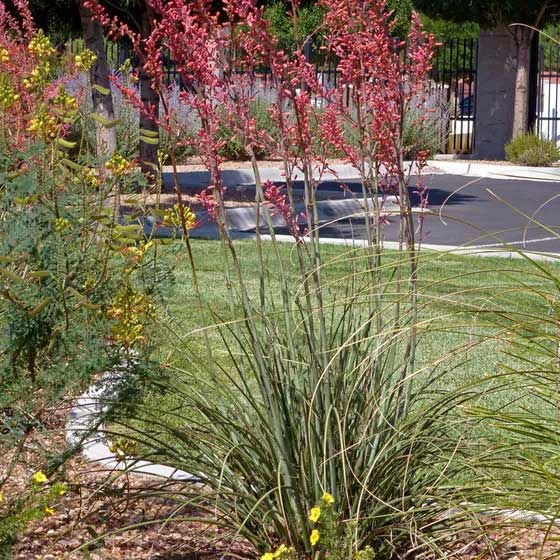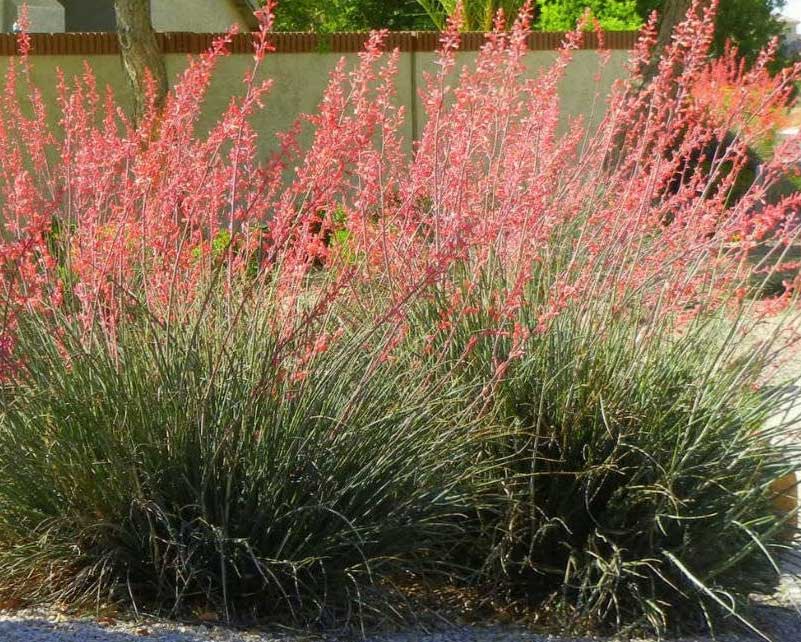Red Yucca

Botanical Name: Hesperaloe parviflora
Category: sub-shrub
Divisible: Yes
Common Name: Red Yucca
Evergreen: Yes
Propagation: Seed, division
Family:Asparagaceae (Century plant)
Invasive: No
Size: 24-36″ tall x 36″ wide
Not truly a yucca, Red yucca is sun loving and a tough, drought-tolerant plant. It’s narrow evergreen leaves have a fringe of white threadlike hairs along their edges and form a stiff arching habit with dramatic ascending spikes of colorful flowers in spring.
Red Yucca thrives in nearly any well-drained soil, but sandy soil is best. Young plants may be small, but they will spread relatively quickly. Water regularly for the first year but not to the point of sogginess. Thereafter, water occasionally especially during periods of hot, dry weather but be careful not to overwater.
Flower stalks will produce fruit after blooming. Seed can be gathered from the pods for propagation or left for your birds’ winter food. Remove stalks in the spring.
You can also remove older leaves which will eventually die down and turn brown. When they are ready – just pull them from the base of the plant. Red yucca plants really don’t require fertilizer, but you can feed them lightly before new growth appears in spring. Use a good-quality, general-purpose fertilizer.
It is a clumping plant that grows and divides into numerous plants under ideal conditions. These offshoots can be dug up and replanted. You can also divide established clumps.


My Experience:
Another five star perennial for the high desert garden Red Yucca is so easy to grow and requires little care. In the spring when it’s coral blooms are waving in the breeze it’s a show stopper. The rest of the year it’s spiky foliage adds texture and interest to any garden bed.
These do not like a lot of water and I loved them when they were within beds of perennials but most did not do well with regular irrigation. I have moved them all to those beds that are watered by hand and infrequently and they are happier.
Dividing clumps has not been very successful for me nor have replanting offshoots. The “babies” have not grown quickly.
Growing Red Yucca from Seed:
The germination rate of Red Yucca is variable so always start more seeds than you think you need. Seeds are viable for 5 years from harvest. Indoor starting can be done at any time of year and is the best method for successful germination.
Indoor Start:
- Soak seeds in water for 24 hours. Scarification is not necessary.
- Sow the seeds in trays or pots filled with a gritty mix – soil and sand or cactus mix. Lightly cover with soil mix.
- Keep soil moist and temperatures at 60-70°. Average germination time is 3-4 weeks.
- Give seeds bright indirect light.
- Important: When seedlings are large enough to handle – about 8 weeks -transplant into pots that are at least 4 inches deep. Well drained sandy soil can be used. Allow surface of soil to dry out in between watering.
- As the plants grow repot into 1 gallon pots. Red Yucca develops a long tap root that needs lots of space to develop. After the first year water only when soil is completely dry.
Care and Maintenance:
- Some recommend keeping Red Yucca in pots for the first year or more.
- Once they are ready – plant in dry well draining sandy soil in full sun. Dig a deep enough hole to allow for the long tap root.
- A general purpose fertilizer can be applied – feed lightly in the spring when there are signs of new growth.
Buy Red Yucca seeds from my Etsy shop

0 Comments